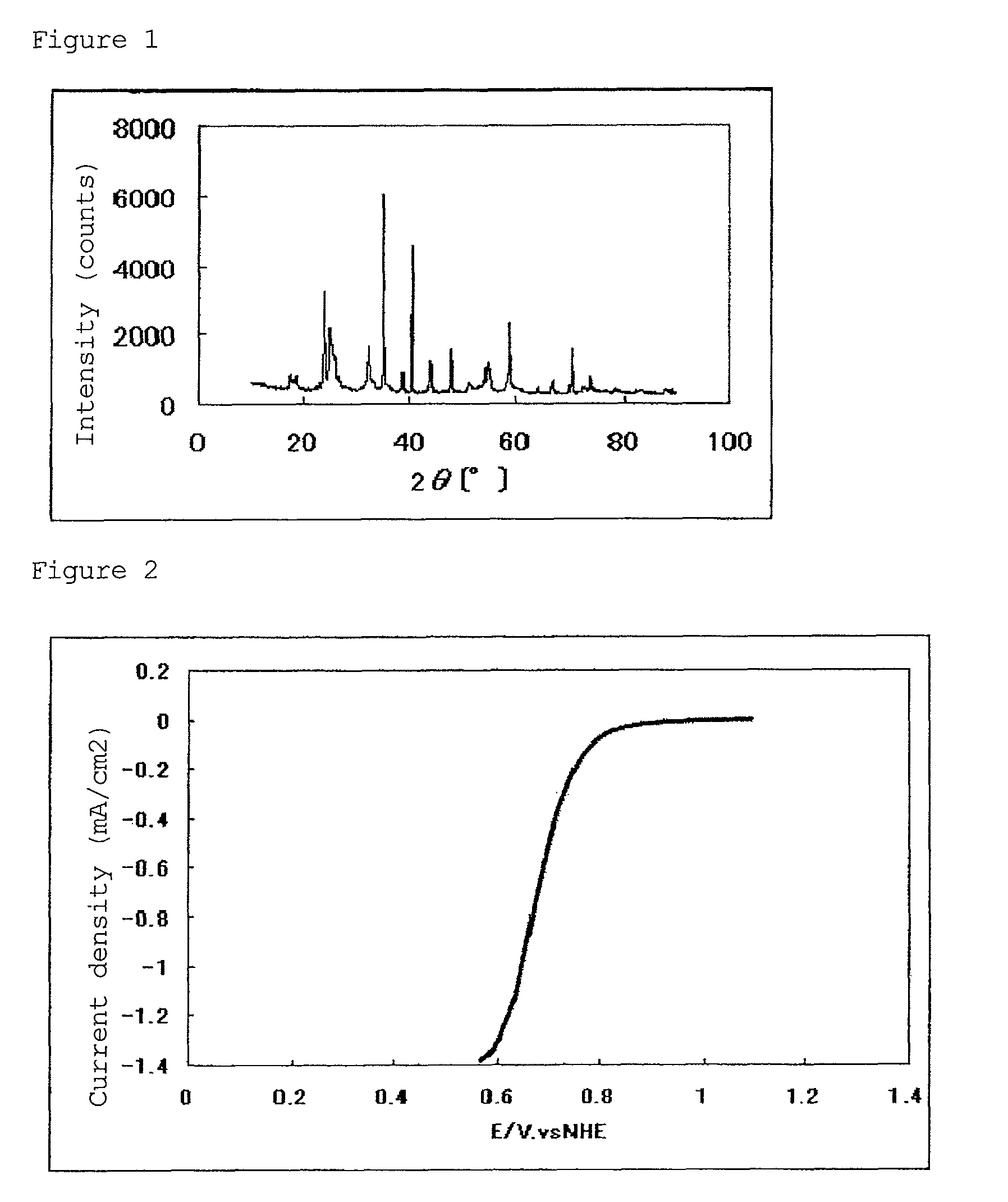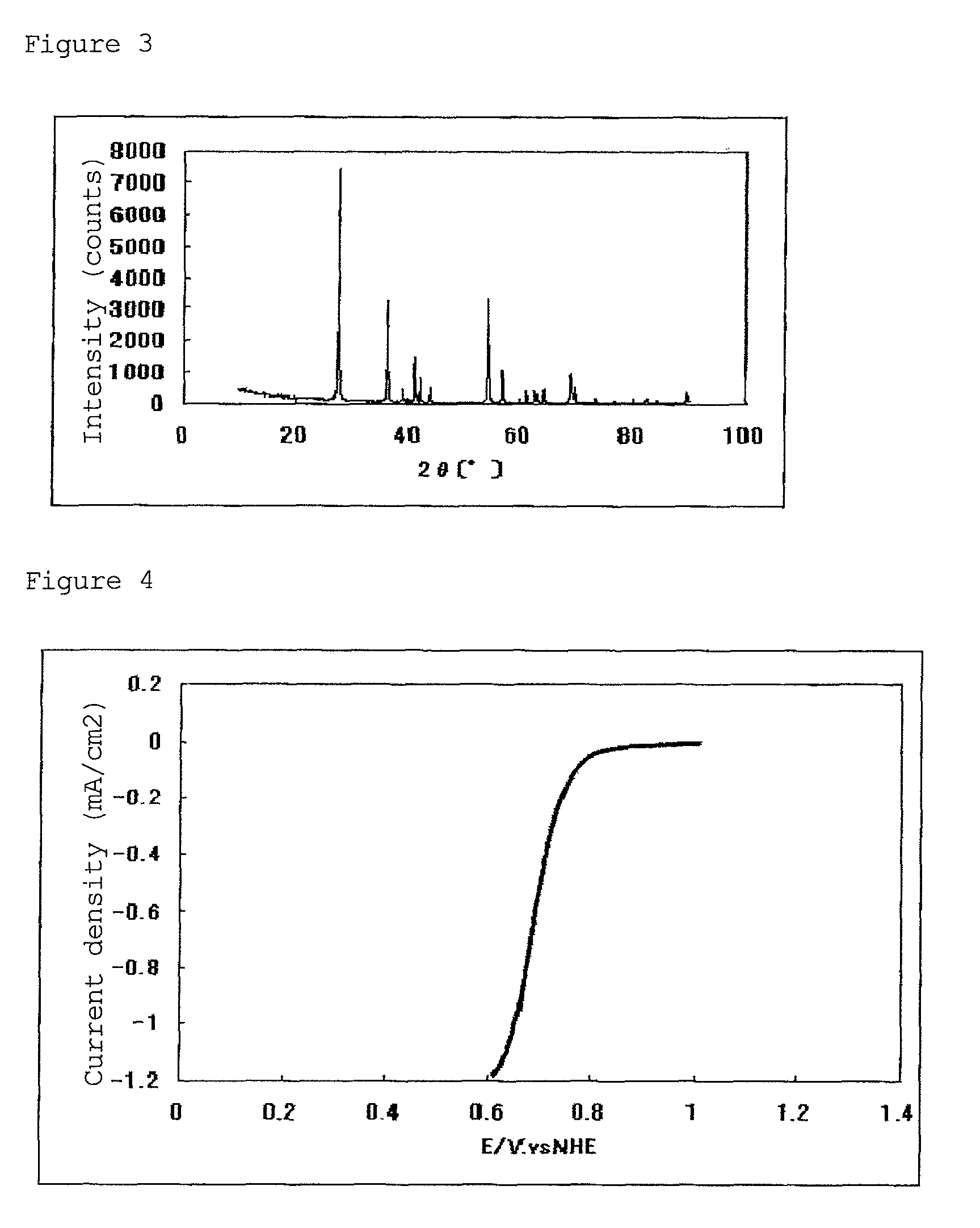Catalyst for fuel cell and polymer electrolyte fuel cell using the same
a fuel cell and polymer electrolyte technology, applied in the direction of electrical equipment, chemical/physical processes, climate sustainability, etc., can solve the problems of high cost of platinum, limited resource quantity, and demand for alternative catalysts, and achieve excellent electric power generation cost, high oxygen reduction activity, and excellent durability
- Summary
- Abstract
- Description
- Claims
- Application Information
AI Technical Summary
Benefits of technology
Problems solved by technology
Method used
Image
Examples
example 1
1. Preparation of Catalytically Active Substance
[0129]2.60 g (21 mmol) of niobium (IV) oxide (NbO2) (available from Kojundo Chemical Laboratory Co., Ltd., purity: 99.9%) was mixed with 600 mg (50 mmol) of sufficiently crushed carbon (available from Cabot Corporation, VULCAN (registered trademark) XC-72 (mean particle diameter: 30 nm)). This mixed powder was heated in a tubular furnace at 1600° C. for 1 hour in a nitrogen atmosphere, whereby 2.55 g of niobium carbonitride was obtained.
[0130]In a tubular furnace, 2.00 g of the resulting niobium carbonitride was heated at 900° C. for 3 hours while flowing argon gas containing 1% by volume of oxygen gas and 2% by volume of hydrogen gas into the furnace, whereby 2.15 g of a niobium oxycarbonitride was obtained. The results of powder X-ray diffraction of the resulting catalytically active substance are shown in FIG. 1. With regard to the composition of the niobium oxycarbonitride (NbCxNyOz), x, y and z proved to be 0.48, 0.15 and 1.29, re...
example 2
1. Preparation of catalytically active substance
[0148]5.10 g (85 mmol) of titanium carbide (TiC) (Soekawa Chemical Co., Ltd., purity: 99%), 0.80 g (10 mmol) of titanium oxide (TiO2) (Kojundo Chemical Laboratory Co., Ltd., purity: 99.9%) and 0.31 g (5 mmol) of titaniumnitride (TiN) (SoekawaChemical Co. , Ltd., purity: 99%) were well mixed and heated at 1800° C. for 3 hours in a nitrogen atmosphere, whereby 5.73 g of a titanium carbonitride was obtained. Because the titanium carbonitride was sintered, it was crushed by an automatic mortar.
[0149]In a tubular furnace, 298 mg of the resulting titanium carbonitride was heated at 1000° C. for 10 hours while flowing nitrogen gas containing 1% by volume of oxygen gas and 4% by volume of hydrogen gas into the furnace, whereby 393 mg of a titanium oxycarbonitride was obtained.
[0150]From the results of the elemental analysis of the resulting titanium oxycarbonitride (TiCxNyOz), x, y and z proved to be 0.12, 0.05 and 1.71, respectively, and x+y+...
example 3
1. Preparation of Catalytically Active Substance
[0157]5.88 g (56 mmol) of niobium carbide (NbC) (Kojundo Chemical Laboratory Co., Ltd., purity: 99%) , 0.40 g (2.5 mmol) of ferric oxide (Kojundo Chemical Laboratory Co., Ltd., purity: 99.9%) and 5.12 g (48 mmol) of niobium nitride (NbN) (Kojundo Chemical Laboratory Co., Ltd., purity: 99%) were sufficiently crushed and mixed. This mixed powder was heat-treated in a tubular furnace at 1600° C. for 3 hours in a nitrogen atmosphere, whereby 11.18 g of a carbonitride containing iron and niobium was obtained. This sintered carbonitride was crushed by a ball mill.
[0158]In a tubular furnace, 1.00 g of the resulting carbonitride was heated at 900° C. for 6 hours while flowing nitrogen gas containing 1% by volume of oxygen gas and 2.0% of hydrogen gas into the furnace, whereby 1.25 g of an oxycarbonitride containing iron (5% by mol) and niobium was obtained. From the results of the elemental analysis of the resulting oxycarbonitride of niobium ...
PUM
| Property | Measurement | Unit |
|---|---|---|
| temperature | aaaaa | aaaaa |
| temperatures | aaaaa | aaaaa |
| diffraction angle 2θ | aaaaa | aaaaa |
Abstract
Description
Claims
Application Information
 Login to View More
Login to View More - R&D
- Intellectual Property
- Life Sciences
- Materials
- Tech Scout
- Unparalleled Data Quality
- Higher Quality Content
- 60% Fewer Hallucinations
Browse by: Latest US Patents, China's latest patents, Technical Efficacy Thesaurus, Application Domain, Technology Topic, Popular Technical Reports.
© 2025 PatSnap. All rights reserved.Legal|Privacy policy|Modern Slavery Act Transparency Statement|Sitemap|About US| Contact US: help@patsnap.com



